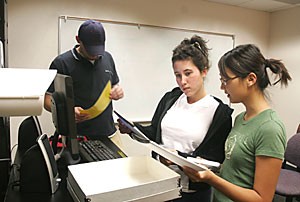As funds from the new library fee are used to develop electronic resources in the UA libraries, a reduction in print materials will occur over the next two years.
The reduction will take place because the Information Access budget has not increased in six years, while the cost of providing text materials has increased, according to the Main Library’s Intranet Web site.
The Arizona Board of Regents approved a $60 Information Technology/Library Fee in March 2006, and this year the fee rose to $115 per student annually.
The libraries received $485,814 from the fee, after removing 10 percent of the total revenue for financial aid, during the 2006-2007 fiscal year, according to a library fee status report.
That money has been going toward materials including electronic resources, software for students in scientific fields, laptops for loan, rooms to practice presentations and desktop access to digital copies.
“”We’re trying to do new things, new services,”” said Carla Stoffle, dean of the UA libraries. “”This year, for the first time, we spent half of our materials expenditures on electronic materials.””
The materials purchased with the fee and budget money are separate. The library will not be using the Information Technology/Library fee to fill in gaps in the budget, Stoffle said.
There will
This really was a good opportunity to make something available that the whole campus could use.
-Barbara Williams,
librarian, Science and Engineering Library, on ChemOffice program
be 870 print journals and 5,800 print monographs cut, according to the Intranet Web site. The site also indicates that libraries will reduce spending on books and journals by around $850,000 over the next two years.
To determine which materials would be cut, the library examined usage and alternative access, such as online access and interlibrary loan. For some journals, access is available online.
Methods for determining the lowest-used periodicals can be problematic, however, as determination is based on which journals are checked out, though some patrons may just browse the materials in the library, Stoffle said.
While the purchasing of print materials may be reduced, the Information Technology/Library fee is expanding the number of electronic resources available to students.
The Science and Engineering Library has been expanding its electronic materials with a $30,000 portion of the fee revenue, said Barbara Williams, an engineering librarian, adding that the money has been used to purchase software for students who use the facility.
The library has purchased a license for a chemistry program called ChemOffice, which allows students to model molecules on the computer rather than draw them by hand, Williams said.
ChemOffice is available to download for any student, faculty or staff member, according to library status reports. The program has been downloaded about 700 times, she said.
The seven computer programs the Science and Engineering Library purchased were used 9,543 times during the 2006-2007 fiscal year, according to library documents.
Many of the software and programs offered are expensive for students to purchase on their own. Purchase a single ChemOffice packet would cost around $710, Williams said.
“”This really was a good opportunity to make something available that the whole campus could use,”” Williams said.
Other technology purchased included a two-year license for Optimal Résumé, a résumé builder, Stoffle said. The program was used by 1,900 students during the 2006-2007 fiscal year, or about 5 percent of the UA student body, according to library status reports.
Typical fees for résumé-builder programs run anywhere from $100-500, Stoffle said. The UA offers the program for free.
Multimedia presentation rooms, where students can record presentations and play them back to critique them, have also been popular with students, Stoffle said.
Students have commented to library staff that the rooms help them improve their test scores, according to the library fee status report.
“”We’ve had one group say that since they’ve discovered these rooms they do their group study there,”” Stoffle said.
While the media may be changing, the UA’s goal of disseminating information to students remains, whether through print or electronic resources.
“”All libraries in major universities are faced with the challenge to have to provide for their users’ needs in multiple formats, including online, digital, multi-media and print,”” Jana Bradley, a library science professor and director of the UA School of Information Resources and Library Science, wrote in an e-mail. “”University libraries, including ours, are still providing access to the print published literature, whether books or journals, but through a balance of print and online format.””









